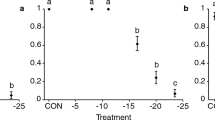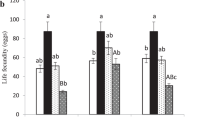Abstract
Cold storage of insect parasitoids is currently used before mass release in the field in biological control programmes. The physiological consequences of constant cold storage are known in various species of parasitic wasps, but there are few reports on the behaviour of survivors and even fewer reports where both sexes were tested. In this study, we observed the consequences of a long storage of Aphidius rhopalosiphi De Stephani Perez (Hymenoptera: Braconidae), a parasitoid of the cereal aphid Sitobion avenae Fabricius (Hemiptera: Aphididae), at low temperature on some key behavioural decisions that both sexes will make when released in the field. Males are less tolerant than females and both sexes suffer from a long exposure (28 days or more) at 4°C during the pupal stage: alteration of olfactory responses, decrease in mating capacity and decrease in the efficiency of patch exploitation by females.



Similar content being viewed by others
References
Adedokun TA, Denlinger L (1985) Metabolic reserves associated with pupal diapause in the flesh fly, Sarcophaga crassipalpis. J Insect Physiol 31:229–233
Ali MF, Abdel-Reheem EFM, Abdel-Rahman HA (1997) Effect of temperature extremes on the survival and biology of the carpet beetle, Attagenus fasciatus (Thunberg) (Coleoptera: Dermestidae). J Stored Prod Res 33:147–156
Amice G, Vernon P, Outreman Y, van Alphen J, van Baaren J (2008) Variability in responses to thermal stress in parasitoids. Ecol Entomol 33:701–708
Anderson JF, Horsfall WR (1963) Thermal stress and anomalous development of mosquitoes (Diptera: Culicidae). I. Effect of constant temperature on dimorphism of adults of Aedes stimulans. J Exp Zool 154:67–107
Ardeh MJ, de Jong PW, Loomans AJM, van Lenteren JC (2004) Inter- and intraspecific effects of volatile and nonvolatile sex pheromones on males, mating behavior, and hybridization in Eretmocerus mundus and E. eremicus (Hymenoptera: Aphelinidae). J Insect Behav 17:745–759
Arnqvist G, Nilsson T (2000) The evolution of polyandry: multiple mating and female fitness in insects. Anim Behav 60:145–164
Bale JS (1987) Insect cold hardiness: freezing and supercooling—an ecophysiological perspective. J Insect Physiol 33:899–908
Bourdais D, Vernon P, Krespi L, le Lannic J, van Baaren J (2006) Antennal structure of male and female Aphidius rhopalosiphi DeStefani-Peres (Hymenoptera:Braconidae): description and morphological alterations after cold storage or heat exposure. Microsc Res Tech 69:1005–1013
Brévault T, Quilici S (2000) Relationships between temperature, development and survival of different life stages of the tomato fruit fly, Neoceratitis cyanescens. Entomol Exp Appl 94:25–30
Campbell A, Frazer BD, Gilbert N, Gutierrez AP, Mackauer M (1974) Temperature requirements of some aphids and their parasites. J Appl Ecol 11:431–438
Carrière Y (2003) Haplodiploidy, sex, and the evolution of pesticide resistance. J Econ Entomol 96:1626–1640
Carrière Y, Boivin G (2001) Constraints on the evolution of thermal sensitivity of foraging in Trichogramma: genetic trade-offs and plasticity in maternal selection. Am Nat 157:570–581
Clarke GM, Brand GW, Whitten MJ (1986) Fluctuating asymmetry: a technique for measuring developmental stress caused by inbreeding. Aust J Biol Sci 39:145–154
Colinet H, Hance T (2009) Male reproductive potential of Aphidius colemani (Hymenoptera: Aphidiinae) exposed to constant or fluctuating thermal regimens. Environ Entomol 38:242–249
Colinet H, Hance T, Vernon P (2006) Water relations, fat reserves, survival, and longevity of a cold-exposed parasitic wasp Aphidius colemani (Hymenoptera: Aphidiinae). Environ Entomol 35:228–236
David JR, Araripe LO, Chakir M, Legout H, Lemos B, Pétavy G, Rohmer C, Joly D, Moreteau B (2005) Male sterility at extreme temperatures: a significant but neglected phenomenon for understanding Drosophila climatic adaptations. J Evol Biol 18:838–846
Ellers J, van Alphen JJM, Sevenster JG (1998) A field study of size–fitness relationships in the parasitoid Asobara tabida. J Anim Ecol 67:318–324
Farrell JA, Stufkens MW (1990) The impact of Aphidius rhopalosiphi (Hymenoptera: Aphidiidae) on populations of the rose grain aphid (Metopolophium dirhodum) (Hemiptera: Aphididae) on cereals in Canterbury, New Zealand. Bull Entomol Res 80:377–383
Godfray HCJ (1994) Parasitoids: behavioral and evolutionary ecology. Princeton University Press, Princeton
Guerrieri E, Pedata PA, Romani R, Isidoro N, Bin F (2001) Functional anatomy of male antennal glands in three species of Encyrtidae (Hymenoptera: Chalcidoidea). J Nat Hist 35:41–54
Hance T, van Baaren J, Vernon P, Boivin G (2007) Impact of extreme temperatures on parasitoids in a climate change perspective. Annu Rev Entomol 52:107–126
Hanna AD (1935) Fertility and toleration of low temperature in Euchalcidia caryobori, Hanna (Hymenoptera, Chalcidinae). Bull Entomol Res 26:315–322
Hay DB, Vinson SB (1971) Acceptance of Heliothis virescens (F.) (Lepidoptera, Noctuidae) as a host by the parasite Cardiochiles nigriceps Viereck (Hymenoptera, Braconidae). Anim Behav 19:344–352
Herard F, Keller MA, Lewis WJ, Tumlinson JH (1988) Beneficial arthropod behavior mediated by airborne semiochemicals. III. Influence of age and experience on flight chamber responses of Microplitis demolitor Wilkinson. J Chem Ecol 14:1553–1596
Hochachka PW, Somero GN (2002) Biochemical adaptation: mechanism and process in physiological evolution. Oxford University Press, Oxford
Isidoro N, Bin F, Colazza S, Vinson SB (1996) Morphology of antennal gustatory sensilla and glands in some parasitoid hymenoptera with hypothesis on their role in sex and host recognition. J Hymenopt Res 5:206–239
Ismail M, Vernon P, Hance T, van Baaren J (2010) Physiological costs of cold exposure on the parasitoid Aphidius ervi, without selection pressure and under constant or fluctuating temperatures. BioControl 55:729–740
Langer A, Hance T (2000) Overwintering strategies and cold hardiness of two aphid parasitoid species (Hymenoptera: Braconidae: Aphidiinae). J Insect Physiol 46:671–676
Langer A, Stilmant D, Verbois D, Hance Th (1997) Seasonal activity and distribution of cereal aphid parasitoids in Belgium. BioControl 42:185–191
Lee RE Jr, Denlinger DL (1991) Insects at low temperature. Chapman and Hall, London and New York
Lee RE Jr, Denlinger DL (2010) Rapid cold hardening: ecological significance and underpinning mechanisms. In: Denlinger DL, Lee RE Jr (eds) Low temperature biology of insects. Cambridge University Press, Cambridge, pp 35–58
Levie A, Dogot P, Hance T (2000) Release of Aphidius rhopalosiphi (Hymenoptera: Aphidiinae) for cereal aphid control: field cage experiments. Eur J Entomol 97:527–531
Levie A, Vernon P, Hance T (2005) Consequences of acclimation on survival and reproductive capacities of cold-stored mummies of Aphidius rhopalosiphi (Hymenoptera: Aphidiinae). J Econ Entomol 98:704–708
Muratori F, Le Lannic J, Nénon J-P, Hance T (2004) Larval morphology and development of Aphidius rhopalosiphi (Hymenoptera: Braconidae: Aphidiinae). Can Entomol 136:169–180
Ochieng SA, Park KC, Zhu JW, Baker TC (2000) Functional morphology of antennal chemoreceptors of the parasitoid Microplitis croceipes (Hymenoptera: Braconidae). Arthropod Struct Dev 29:231–240
O’Donnell S, Beshers SN (2004) The role of male disease susceptibility in the evolution of haplodiploid insect societies. Proc Biol Sci 271:979–983
Pérez-Maluf R, Kaiser L (1998) Mating and oviposition experience influence odor learning in Leptopilina boulardi (Hymenoptera: Eucoilidae), a parasitoid of Drosophila. Biol Control 11:154–159
Pierre J-S, Kasper C (1990) Analyse de la structure et de la variabilité du comportement de ponte de l’hyménoptère parasitoïde Aphidius uzbekistanicus Luz. dans son hôte, le puceron des céréales Sitobion avenae F. Apport de l’analyse de données à la définition des item comportementaux. Biol Behav 15:152–168
Rinehart JP, Yocum GD, Denlinger DL (2000) Thermotolerance and rapid cold hardening ameliorate the negative effects of brief exposures to high or low temperatures on fecundity in the flesh fly, Sarcophaga crassipalpis. Physiol Entomol 25:330–336
Rivero A, West SA (2002) The physiological costs of being small in a parasitic wasp. Evol Ecol Res 4:407–420
Roux O, van Baaren J, Gers C, Arvanitakis L, Legal L (2005) Antennal structure and oviposition behavior of the Plutella xylostella specialist parasitoid: Cotesia plutellae. Microsc Res Tech 68:36–44
Scott M, Berrigan D, Hoffmann AA (1997) Costs and benefits of acclimation to elevated temperature in Trichogramma carverae. Entomol Exp Appl 85:211–219
Sehnal F (1991) Effects of cold on morphogenesis. In: Lee RE Jr, Denlinger DL (eds) Insects at low temperature. Chapman and Hall, London and New York, pp 149–171
Shreve SM, Kelty JD, Lee RE Jr (2004) Preservation of reproductive behaviors during modest cooling: rapid cold-hardening fine-tunes organismal response. J Exp Biol 207:1797–1802
Sigsgaard L (2000) The temperature-dependent duration of development and parasitism of three cereal aphid parasitoids, Aphidius ervi, A. rhopalosiphi, and Praon volucre. Entomol Exp Appl 95:173–184
Sinclair BJ, Vernon P, Klok CJ, Chown SL (2003) Insects at low temperatures: an ecological perspective. Trends Ecol Evol 5:257–262
Smith DR, Crespi BJ, Bookstein FL (1997) Fluctuating asymmetry in the honey bee, Apis mellifera: effects of ploidy and hybridization. J Evol Biol 10:551–574
Sømme L (1982) Supercooling and winter survival in terrestrial arthropods. Comp Biochem Physiol Part A Physiol 73:519–543
Stilmant D, van Bellinghen C, Hance T, Boivin G (2008) Host specialization in habitat specialists and generalists. Oecologia 156:905–912
Tezze AA, Botto EN (2004) Effect of cold storage on the quality of Trichogramma nerudai (Hymenoptera: Trichogrammatidae). Biol Control 30:11–16
van Baaren J, Nénon J-P (1996) Host location and discrimination mediated through olfactory stimuli in two species of Encyrtidae. Entomol Exp Appl 81:61–69
van Baaren J, Pierre J-S, Nénon JP (1993) Analysis of oviposition behaviour in the parasitoid Epidinocarsis lopezi (Hym.: Encyrtidae): comparison of flow charts on factorial maps. BioControl 38:207–218
van Baaren J, Bonhomme A-S, Deleporte P, Pierre J-S (2003) Behaviours promoting grouping or dispersal of mother and neonates in ovoviviparous cockroaches. Insect Soc 50:45–53
van Baaren J, Outreman Y, Boivin G (2005) Effect of low temperature exposure on oviposition behaviour and patch exploitation strategy in parasitic wasps. Anim Behav 70:153–163
van Baaren J, Le Lann C, Pichenot J, Pierre J-S, Krespi L, Outreman Y (2009) How could host discrimination abilities influence the structure of a parasitoid community? Bull Entomol Res 99:299–306
van Handel E (1993) Fuel metabolism of the mosquito (Culex quinquefasciatus) embryo. J Insect Physiol 39:831–833
Vinson SB (1981) Habitat location. In: Nordlund DA, Jones RL, Lewis WJ (ed) Semiochemicals their role in pest control. John Wiley and Sons, New York, pp 51–77
Wang X, Green DS, Roberts SP, de Belle JS (2007) Thermal disruption of mushroom body development and odor learning in Drosophila. PLoS ONE 2(11):e1125
Weselow RM (1972) Sense organs of the hyperparasite Cheiloneurus noxius (Hymenoptera: Encyrtidae) important in host selection process. Ann Entomol Soc Am 65:41–46
Acknowledgments
We thank D. Webb (Rennes University), M. O’Neill and the three anonymous referees for their constructive and valuable comments on the manuscript. We also thank A. Bertrand for the assistance with some of experiments on females. This paper is number BRC205 of the Biodiversity Research Centre.
Author information
Authors and Affiliations
Corresponding author
Additional information
Handling Editor: Stefano Colazza
Rights and permissions
About this article
Cite this article
Bourdais, D., Vernon, P., Krespi, L. et al. Behavioural consequences of cold exposure on males and females of Aphidius rhopalosiphi De Stephani Perez (Hymenoptera: Braconidae). BioControl 57, 349–360 (2012). https://doi.org/10.1007/s10526-011-9396-0
Received:
Accepted:
Published:
Issue Date:
DOI: https://doi.org/10.1007/s10526-011-9396-0




